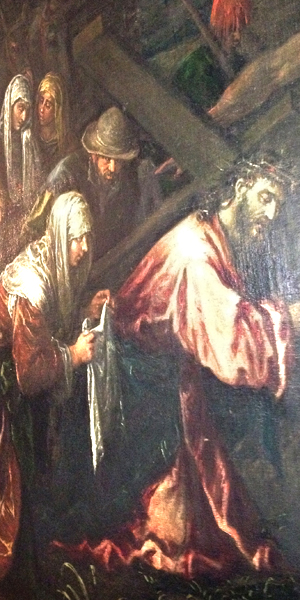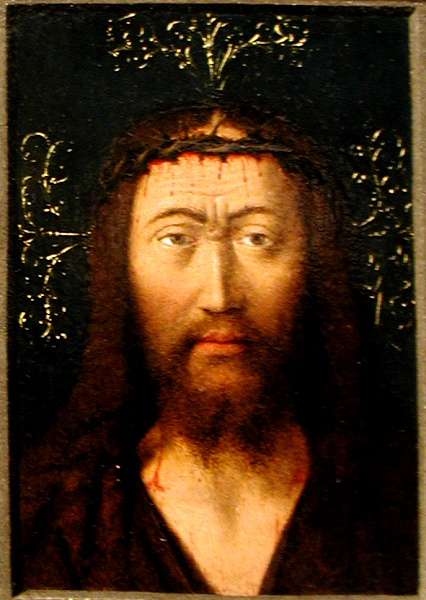What then happened to the cloth is not explained in The Avenging of the Savior nor in the retellings in The Death of Pilate and the Golden Legend. But a cloth with a face purporting to be Christ's was an object of veneration in Rome from at least the beginning of the 8th century, when John VII had an altar constructed for it in St. Peter's.3 In the 13th century Innocent III organized a procession with the cloth and had a hymn written, the Ave sancta facies, to honor the "Holy Face…impressed on a kerchief whiter than snow and given to Veronica as a sign of love."4 Later Dante refers to it in Paradiso 31, comparing his awe at seeing St. Bernard to that of a pilgrim come to Rome from far away who is "never sated" in contemplating "our Veronica."
Both the hymn and the comment from Dante help us understand the iconography of the paintings. They typically present the cloth as kerchief-size and bright white. More important, they function as aids to the kind of contemplative awe that Dante was describing. While St. Veronica looks down or to the side (as in the first picture at right), the Holy Face directly engages the beholder's gaze.
The first picture at right is typical of the representation of Veronica in 15th- and 16th-century paintings. She will look to be in her 20s or early middle age. Called a "matron" in the texts, she usually wears a kerchief, which is often made to seem like a twin to the one with the Holy Face.
In some texts her husband is a "St. Amator" who travels with her to evangelize in France.5 Amator eventually becomes a subject of images on his own (example).
The hymn and the passage from Dante also exemplify the ambiguity in the word veronica. The hymn speaks of Veronica as a person, while Dante's "our Veronica" clearly means the cloth. In the following century Chaucer's Pardoner will wear a pilgrim's badge called a vernycle (i.e., a "small veronica") with a miniature of the Holy Face.6 Modern scholars assume that it was the cloth that first had the name, which appears to be a combination of Latin vera "true" and Greek eikon, "image."7 The name of the object must have become the name of a person at some time before the writing of The Avenging of the Savior, but when or how is unknown.
Paintings like the first one at right continue in popularity through the 15th century. Then in the 16th we also start to see images that assume that it was on the way to Calvary that Jesus imprinted his face, not at some point during his years of ministry. Examples include the second picture on the right and this painting by Leonardo Corona. The earliest texts to make this claim cited by the Acta Sanctorum are a travel memoir from 1483 and a chronicle from 1486.8 But it is likely that this revisionist version of the legend existed earlier, because there is a 1420 Veronica portrait in which Christ is wearing the crown of thorns, a detail that assumes the imprint was made during his Passion.
Enthusiasm regarding Veronica as a saint kept growing through the 15th and 16th centuries. In 1556 a Franciscan monastery was dedicated to her in Murcia, Spain. In 1560 a mass for her feast day was added to the Ambrosian Missal in Milan, although it was removed later in the century. She was introduced into a proposed revision of the Roman Martyrology in 1577.9 The 17th century saw the growing practice of displaying "Stations of the Cross" in churches. These presented the events of the Passion in a sequence of images, always including Veronica's proffer of her veil to Jesus.10
The face itself was also a subject for paintings such as the third picture on the right from the 15th century or this fresco from the 16th that combines the cloth with a chalice, a Eucharistic host, and two skulls.
In North American Catholic churches, Veronica is often seen in the sixth of the fourteen Stations of the Cross displayed along the walls of the nave.
Prepared in 2015 by Richard Stracke, Emeritus Professor of English, Augusta University. Revised 2017-07-31, 2021-11-22.
HOME PAGE

Detail of a fresco in the Church of St. Justina, Padua (See description page)

Jacopo Bassano, The Way to Calvary, 1565 (See description page)

Antonello da Messina, 1445 (See description page)
MORE IMAGES
- 1325-75: A sculpted image of the sudarium on a capital.
- 1510-20: Facing pages in the Spinola Hours present the Veronica miracle on one side and Jesus on the other side with the Ave sancta facies prayer.
- Undated: St. Veronica in a fresco with St. Helena and another female saint.
- Undated: A fresco of St. Veronica with Saints Lucy and Apollonia.
Ave Sancta Facies
Hail, holy face of our redeemer,
In which shines the beauty of divine splendor,
Printed on a cloth of snowy white,
Given to Veronica as a sign of love,
We pray you, be all our help,
Our sweet rest and consolation,
So that noisome burdens may not harm us,
But that we enjoy repose among the blessed.11
DATES
- When celebrated at all, St. Veronica's feast was usually observed on February 4 or July 12. She is not recorded in the Roman Martyrology.
NAMES
- Several of the legends claim that Veronica was the woman cured of the flow of blood in Luke 8:43-48. Butler (III, 83) points out that in the eastern churches that woman is known as "Berenike," Greek for "victory-bringer," and that St. Veronica's name is rendered in some western sources as Verenice. Thus it is just possible Veronica may have gotten her name not from an otherwise unattested vera eikon but from the woman in the gospel.
- Rocamadour ("Amator's cliff") in southern France is named for Veronica's husband St. Amator. In the legend, he became a hermit after her death, retiring to the eponymous hillside. In later years it became a pilgrimage destination. See Acta Sanctorum, August vol. 4, 17.
- The cloth is variously referred to as a veil or kerchief or sudarium. The latter term, from the Latin word for sweat, refers to its having been used to wipe Jesus' face.
BIOGRAPHY
- The Avenging of the Savior, 6th century or later.
- The Death of Pilate, Who Condemned Jesus, 7th or 8th century.
- Episode in Golden Legend #53, "The Passion of Our Lord."
- Veronica figures briefly in Jesus' trial in the Gospel of Nicodemus
- Acta Sanctorum, February vol. 1, 449-457.
ALSO SEE
NOTES
1 Acta Sanctorum, February vol. 1, 451. This particular revision of the Roman Martyrology was prepared by Peter Galesinius and published in Milan in 1577, but it was never officially accepted. See Chalmers, XV, 237 and Watt, I, 396.
2 "The Avenging of the Savior," in Ante-Nicene Fathers, vol. 8.
3 Acta Sanctorum, February vol. 1, 455.
4 Ibid., 452.
5 The earliest such text is attributed, not entirely convincingly, to Liutprand, the 10th-century historian. Several other texts of the 14th and 15th century repeat the story. See Acta Sanctorum, ibid., 453-54, and August vol. 4, 16-25 (the essay on St. Amator). St. Amator's feast day is August 20.
6 Benson, Canterbury Tales, I, 687 and note.
7 Butler, III, 83.
8 Acta Sanctorum, ibid., 450, 451.
9 Acta Sanctorum, ibid., 452-53, 452, 451.
10 Catholic Encyclopedia, s.v. "Stations of the Cross."
11 My translation. The hymn is in Mencken, VI, i, 326:
Salve, sancta facies nostri redemtoris,
In qua nitet species divini splendoris,
Impressa panniculo nivei candoris,
Dataque Veronica signum ob amoris,
Este nobis, quæsumus, tutum adiuvamen,
Dulce refrigerium atque consolamen,
Ut novis non noceat hostile gravamen,
Sed fruemur requie cum beatis. Amen.